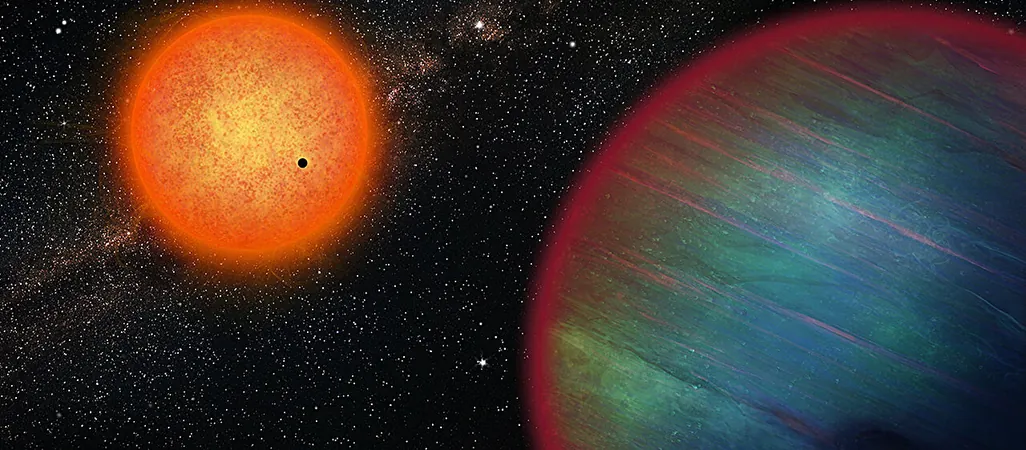
Shattering Planet Formation Myths: Hot Jupiters Not Always Alone!
2025-01-15
Author: Ming
Recent astronomical studies are upending long-held beliefs about Hot Jupiters—massive gas giants that typically orbit closely around their stars. Initially, researchers believed that as these planets migrate inward towards their host stars, they either accumulated or expelled any other neighboring planets due to gravitational forces. However, groundbreaking new research, spearheaded by the University of Geneva (UNIGE), reveals a captivating exception to this rule.
A collaborative research team, including experts from the National Center of Competence in Research (NCCR) PlanetS, the Universities of Bern (UNIBE) and Zurich (UZH), along with international partners, has discovered a fascinating planetary system known as WASP-132. This system defies expectations by hosting a Hot Jupiter, alongside an inner Super-Earth and a distant icy giant planet, challenging the previously established paradigm regarding planetary migration.
What Sets WASP-132 Apart?
Hot Jupiters are defined by their significant mass—similar to that of Jupiter—but orbit their stars at distances significantly smaller than Mercury’s orbit around the Sun. Traditionally, it was thought that there wasn’t enough gas and dust near a star to allow for the formation of such massive planets in close proximity. Hence, astronomers concluded these planets must have formed further out before migrating inwards.
Prior to these latest findings, scientists consistently observed Hot Jupiters orbiting in isolation, isolated from other planets. This pattern seemed substantiated by a theoretical framework suggesting that their inward migration led to the removal of any inner planets. However, the latest revelations about the WASP-132 system indicate that the patterns of planetary formation and migration could be far more complex than previously acknowledged.
The Unique Architecture of WASP-132
The WASP-132 planetary system is exceptional. It comprises a Hot Jupiter that completes its orbit around its star in just over seven days, a Super-Earth—significantly closer to the star than the Hot Jupiter—that orbits in approximately 24 hours, and a massive icy giant planet that takes five years to circle the star. Additionally, researchers have identified a substantial outer companion, likely a brown dwarf, that orbits at a considerable distance.
"This system serves as a remarkable laboratory for studying the formation and evolution of multi-planetary configurations,” said François Bouchy, an associate professor in the Astronomy Department at UNIGE and one of the study's co-authors. "The coexistence of a Hot Jupiter with an inner Super-Earth and an outer giant planet fundamentally alters our understanding of how these systems are formed."
Long-Term Observations Lead to Groundbreaking Insights
The determination of the planetary system’s dynamics stems from nearly two decades of meticulous observations of the star WASP-132, beginning in 2006 within the framework of the Wide-Angle Search for Planets (WASP) program. By 2012, the culmination of over 23,000 photometric measurements identified the planetary candidate WASP-132b. Subsequent studies involving advanced instruments like the CORALIE spectrograph further confirmed its existence and identified additional planets in the same system.
Significantly, in late 2021, NASA's TESS space telescope discovered a transiting Super-Earth in this system, which unveiled a planet size nearly double that of Earth and completes its orbit in a mere 1.01 days.
Revisiting Planet Formation Theories
The intriguing arrangement within the WASP-132 system suggests a revised understanding of planetary migration. The discovery of both an inner Super-Earth and an outer giant planet indicates a more stable migration process, contradicting the past assumption that the inward migration of a Hot Jupiter would clear out other planets. It appears that the Hot Jupiter maintained a relatively undisturbed environment for its planetary neighbors.
Measurements have also provided insights into the density and composition of these planets. For instance, WASP-132b shows an enrichment of heavy elements in line with existing gas giant formation theories, while the Super-Earth reveals a metal and silicate-dominated composition resembling that of Earth.
Conclusion: The New Era of Exoplanet Studies
The findings regarding the WASP-132 system underscore the diversity and complexity inherent in multi-planetary systems, heralding the need for further extensive, high-precision observational campaigns. As researchers continue to unravel the mysteries of exoplanetary systems, we move closer to a more comprehensive understanding of the universe's wide-ranging planetary architectures.
This discovery is not just a scientific milestone; it opens the door to new investigations that could shift the framework on how we perceive planetary systems, urging us to rethink our theories about the formation and evolution of planets in the cosmos. Who knows what other surprises the universe still holds? Stay tuned!

 Brasil (PT)
Brasil (PT)
 Canada (EN)
Canada (EN)
 Chile (ES)
Chile (ES)
 Česko (CS)
Česko (CS)
 대한민국 (KO)
대한민국 (KO)
 España (ES)
España (ES)
 France (FR)
France (FR)
 Hong Kong (EN)
Hong Kong (EN)
 Italia (IT)
Italia (IT)
 日本 (JA)
日本 (JA)
 Magyarország (HU)
Magyarország (HU)
 Norge (NO)
Norge (NO)
 Polska (PL)
Polska (PL)
 Schweiz (DE)
Schweiz (DE)
 Singapore (EN)
Singapore (EN)
 Sverige (SV)
Sverige (SV)
 Suomi (FI)
Suomi (FI)
 Türkiye (TR)
Türkiye (TR)
 الإمارات العربية المتحدة (AR)
الإمارات العربية المتحدة (AR)